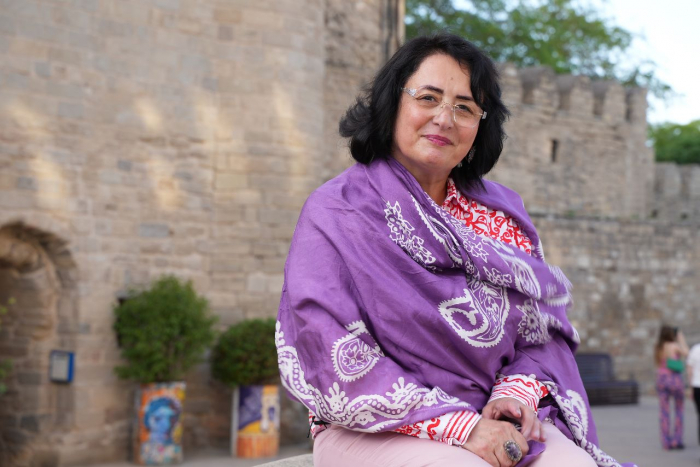By Aida Eyvazlı GÖYTÜRK
We Azerbaijani Turks, like the Japanese are from the country of those who welcome the Sun. We also love the sun and warmth. We also love the Sakura color of the world, the blue color. We also want peace and tranquility in the world.
However, when a person who loves his homeland sees that it is occupied and out of his hands, the duty of citizenship, the love of the land and homeland given to him by Tengri, inevitably wins.
On September 27, 2020, we went to war for the return of our lands that were under the enemy's foothold for nearly 30 years. Our sons went to battle happily. As a result of the unity of the people and the army, we won the 44-day war. We had more than 3000 martyrs.

At the insistence of international organizations, we had to stop the war. According to the terms of the November 10 agreement signed between Russia, Armenia and Azerbaijan, it was agreed that the Armenians will soon leave the occupied Azerbaijani lands with the help of their patrons.
Our goal was peace and tranquility. After liberating a large part of our occupied lands from Armenian occupation for nearly 30 years, we saw our native lands destroyed and turned into ruins. All our national-cultural monuments, sanctuaries, and holy graves were destroyed, the graves of people with a special signature and mark in the history of Azerbaijan were opened, and their bones were stolen.
All the houses, public facilities and residential areas in the occupied territories were destroyed. The enemy did not build or create a single infrastructure in those places for 30 years. Because they knew that the owner of this country and these lands would return someday. A real person does not destroy his beloved homeland, but builds it and construct it.

I want to remind my friends who live in the homeland of the Sakura flower, the famous American journalist and writer Thomas de Waal when visited Aghdam city after the liberation of Karabakh, he said that when he looked from the minaret of the destroyed mosque, Hiroshima was the first thing that came to his mind. Describing the devastation he encountered in those areas in his later book "Karabakh: Armenia and Azerbaijan on the Paths of Peace and War," the journalist writes: "It was a bright spring day and the rugged peaks of the Caucasus Mountains, rising even 100 kilometers to the north, were clearly visible from here. Instead of taking in this view, my eyes were on little Hiroshima below. Previously, Agdam had 50 thousand population, but now there are no people left in this area. After Armenians captured this city in 1993, they looted and destroyed the streets and houses one by one. The destroyed houses were overgrown with brambles and blackberry bushes. I looked at the ruined city from the minaret and once again thought about the reasons for this apocalypse."

Of course, it is not accidental that the American journalist compares Agdam with Hiroshima. The peaceful population of the first of these cities was the victim of the US military, and the second was the victim of Armenian vandals. On August 6, 1945, 140,000 people lost their lives as a result of the explosion of the atomic bomb, which the US military politely called "Little" and 100,000 Azerbaijanis were brutally murdered as a result of the Armenian crusade to Karabakh.
With the efforts and will of the Japanese government, the city of Hiroshima was completely restored in the early 1960s. A Peace Memorial Park with a total area of more than 12 hectares was built on the banks of the Motoyashu River - the place where the atomic bomb exploded. Currently, there is a Peace Memorial Museum, a Peace Ceremonial Bell and numerous monuments in that park. People who experienced the horrors of Hiroshima understand our pain and problems better.
Today we Azerbaijanis and countries that are friendly to us are taking the lands we freed from occupation out of resuscitation. Now we have built an international airport in Fuzuli. Residents of Zangilan city have started to return to their homeland after 30 years of longing. We often hold international music competitions in the city of Shusha, which can be considered the pearl of world music culture. From Shusha, symphonies of peace, freedom, and friendship spread around.
We are opening the Zangezur Corridor and building roads, so that the roads of the modern world will return to the 2500-year-old Great Silk Road.
Peace-loving friends and countries who love us build roads, houses and schools in our liberated lands. We are rebuilding our monuments that were destroyed by the enemy. We are doing all this in order to establish peace in the region.
Cultures start from roads. Once our roads are reconstructed, we will restore our burned forests and destroyed ecology. We know that, in accordance with the terms of economic cooperation between Azerbaijan and Japan, works are currently underway to transform Karabakh into a green energy zone, and the involvement of Japanese companies in these works is also a priority. Besides, Japanese companies will also be closely involved in clearing mines buried by Armenians in Karabakh and other occupied territories.
In demined areas we provide eco system and create green zones. We show our friends who come to Shusha in the spring months the Khari-Bulbul flower, which is considered our symbol of freedom, love and victory, which grows in those mountains. Just as our spring flowers are similar to each other, our love and dreams are also similar to each other. I hope that one day the Sakura tree will bloom in Shusha, Khankendi and Khojaly.

More about:
















































